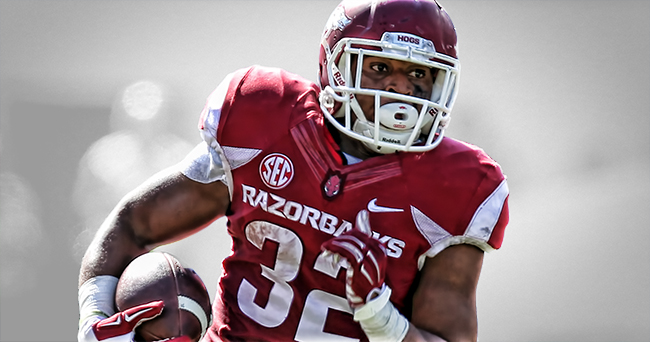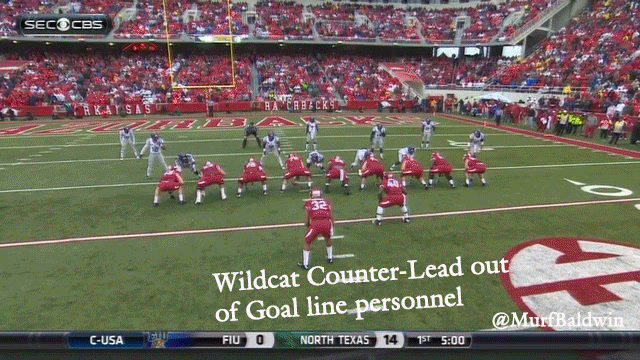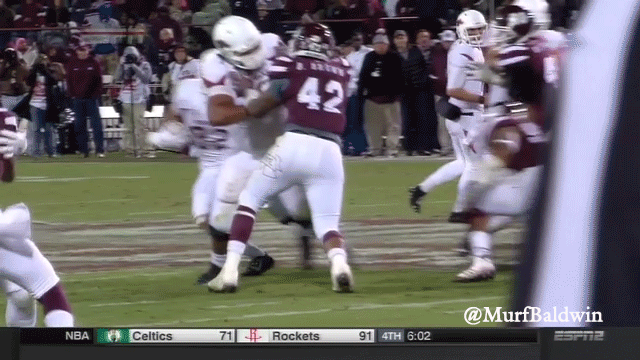Film Study: Arkansas' Jonathan Williams is the most complete RB in the country
As is the case with life, college football seems to be so cyclical.
It seemed like just yesterday that the Southeastern Conference was in its Golden Age for transcendent talent at the quarterback position. (Actually it was yesterday!)
QBs like Johnny Manziel (Texas A&M), A.J. McCarron (Alabama), Aaron Murray (Georgia) and Zach Mettenberger (LSU) all starred for their respective teams at the same time, with the first three arguably being the greatest QBs in school history.
Before that, running backs like Mark Ingram (Bama), Trent Richardson (Bama), Ben Tate (Auburn), Michel Dyer (Auburn), Knile Davis (Arkansas), Steven Ridley (LSU), Brandon Bolden (Ole Miss), Vick Ballard (Mississippi State), Zac Stacy (Vanderbilt) and Isaiah Crowell (Georgia) all chewed up yardage and clock in what was undoubtedly the running back era.
But just like clockwork, with the majority of the media saying the SEC may have its worst group of QBs in quite awhile, the conference is stacked with future NFL players at the RB position: Leonard Fournette (LSU), Darrel Williams (LSU), Nick Chubb (Georgia), Sony Michel, (Georgia) Derrick Henry (Alabama), Kenyan Drake (Alabama), Jalen Hurd (Tennessee), Alvin Kamara (Alabama), Jovon Robinson (Auburn) and Roc Thomas (Auburn). (Among others.)
As it pertains to the University of Arkansas, highly touted, former 5-star RB Alex Collins has been the apple of the fan base’s eye since his unfortunate bizarre recruitment, which saw him go against the grain and commit to the Razorbacks against the wishes of his mother.
After his mother intercepted his letter of intent like former Hog corner Chris Houston in press-man coverage, and Collins still somehow ended up on the Hill, many had it etched in their minds that “A.C.” was the best thing to come along since the great Darren McFadden.
Au contraire mon frère.
While the 5’11”, 215-pound Collins has been every bit as advertised, going over the 1,000-yard mark in each of his first two seasons in Fayetteville, it’s his backfield counterpart, Jonathan Williams, who has, arguably, proved to be the most effective back in head coach Bret Bielema’s traditional, pound-you-in-the-dirt-like-grass-seeds offensive attack.
Not only is he the most underrated player in the SEC, I wholeheartedly believe he’s the most complete running back in the entire country. And with the amount of talent across the college football landscape, that’s saying a whole mouthful.
Scheme Versatility And Skill Set
I once opined that Arkansas as a team had the most complete rushing attack in the country; it only makes sense that it has a player who can be described as such, too. I marveled at the Hogs’ ability to oscillate between zone and gap-blocking concepts despite the presence of the largest offensive line in football. (Stop me if you’ve heard that before.)
Pin & Pull, Power O, Counter out of Power (H/F, O/F), Power to the weak side of the formation, all in conjunction with sweeps, tosses and outside-zone jaunts means a back has to have agility, vision, quickness, patience, speed, instincts, with a Partridge in a Pear Tree.
So when Bielema took the Arkansas job and, after a fantastic run as the head man at the University of Wisconsin program, watched film on Williams it had to feel like the 12th day of Christmas as he had to remind him of a player he had just coached to a record-setting career, Montee Ball.
The 6’1″, 223-pound Williams and the 5’10”, 215-pound Ball, both have the uncanny ability to stay patient with inside- and outside-zone concepts, which allows for the organic cutback lanes to form. Neither will wow you with their timed track speed; both have enough football speed to run to daylight and generate explosive plays.
Williams has been dubbed a power runner by most pundits, but the more I’ve labbed him, the more his short-area agility stood out as the basis of his game. Collins has some serious shake and bake, but it’s hard not to put Williams in that category as his make-you-miss game has more of a north/south aspect to it.
On this Wildcat Counter-Lead play, Williams showed enough patience to perform the counter portion of the play while allowing for his lead blocking to take shape; his vision and instincts kicked in as he made an approaching defender completely whiff inside the box; Williams’ patience is one of the reason he’s often deployed on Draws and other slow-developing plays.
In fact, it’s nothing to see Williams break multiple tackles on runs that go for a short gain — like in the above sequence.
Check Williams out on that Lead-Draw: He showed the ability to navigate muddy waters and broke tackles he didn’t see coming. Williams is dynamic with or without a fullback, which further lends itself to his versatility with the ball in his hands.
His playing style is very reminiscent of former Bama RB T.J. Yeldon as the 6’1″, 226-pounder is another big back with uncanny short-area agility. Moreover, both player’s versatility extends beyond scheme and approach; they are complete backs that truly add value without the ball being in their hands.
Here’s an aspect that further separates Williams from other high-profile RBs around the country: pass-protection. He’s a ready, willing and able blocker who doesn’t shy away from contact and understands offensive and defensive concepts.
This is what is commonly referred to as an inside-out read; his first read was the weak-side inside linebacker; he quickly re-assessed; he chipped the edge-player on the closed side of the formation.
Another aspect of Williams’ game that is commonly overlooked is his pass-catching ability. He’s an excellent route-runner out of the backfield and, much like Yeldon, doesn’t at all look out of place when motioned out wide to an x-receiver.
His hands are butter soft — which feels quite weird to type about an almost 230-pound man — and his ability to block makes him a severe threat in the screen game as defenses have to respect that part of his game.
Williams is a quiet player who just goes about his business with a workmanlike approach. It’s hard to point to one part of his game as a standout aspect because he’s solid at literally everything: between the tackles and edge-bending runs, zone and man principles, catching out of the backfield or out wide and pass-pro.
He doesn’t possess blinding speed like Fournette or run with a violent nature like former Georgia back Todd Gurley, but he’s fast enough to break off explosive runs and he will periodically break tackles like nobody’s business.
He’s a future franchise back in the mold of Philadelphia Eagles’ star DeMarco Murray, who has similar size at 6’0″, 217 pounds, as both rarely have to leave the field due to their respective vast skill sets.
While others inside the conference — Chubb, Henry, Fournette and even Collins — may receive more publicity, none of those players, yet, have a complete game like Williams.
Better enjoy him now, Hog fans.






